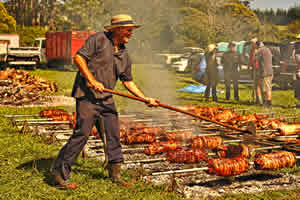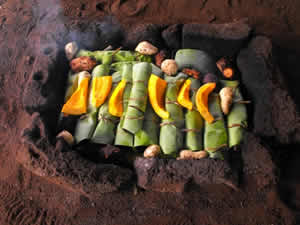Difference between Hangi and Umu
Key Difference: Hangi is the traditional form of cooking for New Zealanders (Maoris). Umu is another name for Hangi, but specifically referring to the process for cooking cabbage trees. It is most commonly used in South Island.
 Hangi is also known as Earth oven. It is the best traditional form of cooking for Maori. The food is cooked by heating rocks which are buried in a pit oven or cooking pit that is the most simple and long-used cooking structures. It is a big ground where large baskets of food are placed on the top of heating stones and everything is covered with earth for several hours before lifting the hangi. The traditional hangi cooking principals are now used primarily for special occasions. The Maori use of this process is identified in their prayers, songs, dance and story telling that go back centuries. A similar method of cooking was and is still used in Chile, the Balkans, and various parts of North Africa and the Middle East.
Hangi is also known as Earth oven. It is the best traditional form of cooking for Maori. The food is cooked by heating rocks which are buried in a pit oven or cooking pit that is the most simple and long-used cooking structures. It is a big ground where large baskets of food are placed on the top of heating stones and everything is covered with earth for several hours before lifting the hangi. The traditional hangi cooking principals are now used primarily for special occasions. The Maori use of this process is identified in their prayers, songs, dance and story telling that go back centuries. A similar method of cooking was and is still used in Chile, the Balkans, and various parts of North Africa and the Middle East.
In the early 19th century, many different hangi methods came into existence. Wire baskets with sacking and cloth replacing leaves and bark as the covering of choice was widely used. Finally in the 21st century, gas heated stainless steel, which is known as ‘hangi machines’ is sometimes used to copy the style of cooking.
 Foods with this method of cooking are prepared in three sections: Meats (pork, beef, lamb, shell fish, fish), kumara, vegetables such as potatoes and puddings.
Foods with this method of cooking are prepared in three sections: Meats (pork, beef, lamb, shell fish, fish), kumara, vegetables such as potatoes and puddings.
- Stones are heated to the white hot stage.
- It uses only untreated wood. Manuka is favored most in New Zealand amongst Maori.
- Food is placed on top meats first (after which the entire Hangi is watered slightly to cause steam to form).
- The food is then covered with flax matting or leaves or both then buried under dirt.
- The food is steam cooked under pressure from the leaves and soil.
- The Hangi must cook or simmer for at least three hours (standard time frame in New Zealand).
- Food is removed from oven and served.
Umu is another name for Hangi, which is most commonly used in South Island to cook cabbage trees, which are a widely branched monocot tree prevalent to New Zealand. Umu was especially used in the older texts. The longest food which was cooked in a large stone lined pit was carrot shaped tap root that was .900 long. It took between 1 to 2 days to cook. The fellow Island neighbors in the Pacific also used this method.
Comparison between Hangi and Umu:
|
|
Hangi |
Umu |
|
Description |
Hangi is the traditional form of cooking for New Zealanders (Maoris). |
Umu is another name for Hangi. |
|
Used in |
New Zealand |
South Island or Pacific |
|
Preparation |
Preparation of the food is the same as preparing the food to be cooked on an electric stove. |
The food is prepared with the same method of cooking on an electric stove. |
|
Food |
Hangi food or kai was traditionally wrapped in leaves, but a modern hangi is more likely to substitute with aluminium foil and wire baskets. |
Umu food was traditionally wrapped with banana fronds and breadfruit, fish, etc. are directly placed on the heated stones. |
Image Courtesy: photo.net, es.wikipedia.org









Comments
Ianeta Taylor
Thu, 04/06/2017 - 03:40
Add new comment